Introduction
In the rapidly evolving landscape of digital transactions, Mobile Commerce (M-Commerce) stands as a revolutionary advancement, transforming how businesses and consumers interact. This article delves into the intricacies of M-Commerce, exploring its definition, types, and the significant impact it has on the retail and financial sectors. With major players like Google and PayPal leading innovation, and the COVID-19 pandemic accelerating the shift towards contactless payments, M-Commerce is not just a trend but a fundamental shift in consumer behavior.
From mobile shopping and payments to banking and advertising, this comprehensive overview highlights how mobile technology is reshaping commerce, offering unparalleled convenience and accessibility. As the industry continues to expand, understanding these dynamics is crucial for businesses aiming to stay competitive in this digital age.
Definition of Mobile Commerce
Commerce conducted through handheld devices, or M-Commerce, signifies the next frontier in the digital transaction landscape, encompassing any transactions carried out via smartphones and tablets. This evolution from traditional e-commerce utilizes portable technology to allow users to buy and sell goods and services using wireless internet connections, providing unparalleled convenience and accessibility. 'The expansion of M-Commerce is fueled by the rising use of mobile financial transactions, including NFC, QR-based, and online digital alternatives, which meet the contemporary consumer's requirement for contactless and on-the-go exchanges.'.
The impact of M-Commerce is profound, with the market predicted to expand significantly, particularly in regions with rising smartphone penetration and financial inclusion capabilities. This growth is evidenced by key players like Google, IBM, and PayPal, who are at the forefront of innovation in the industry. However, the sector faces challenges, such as security concerns and data breaches, which need addressing to sustain its upward trajectory. The COVID-19 pandemic has further accelerated the demand for M-Commerce by highlighting the necessity for contactless payment solutions, making it an essential component of the contemporary retail landscape.
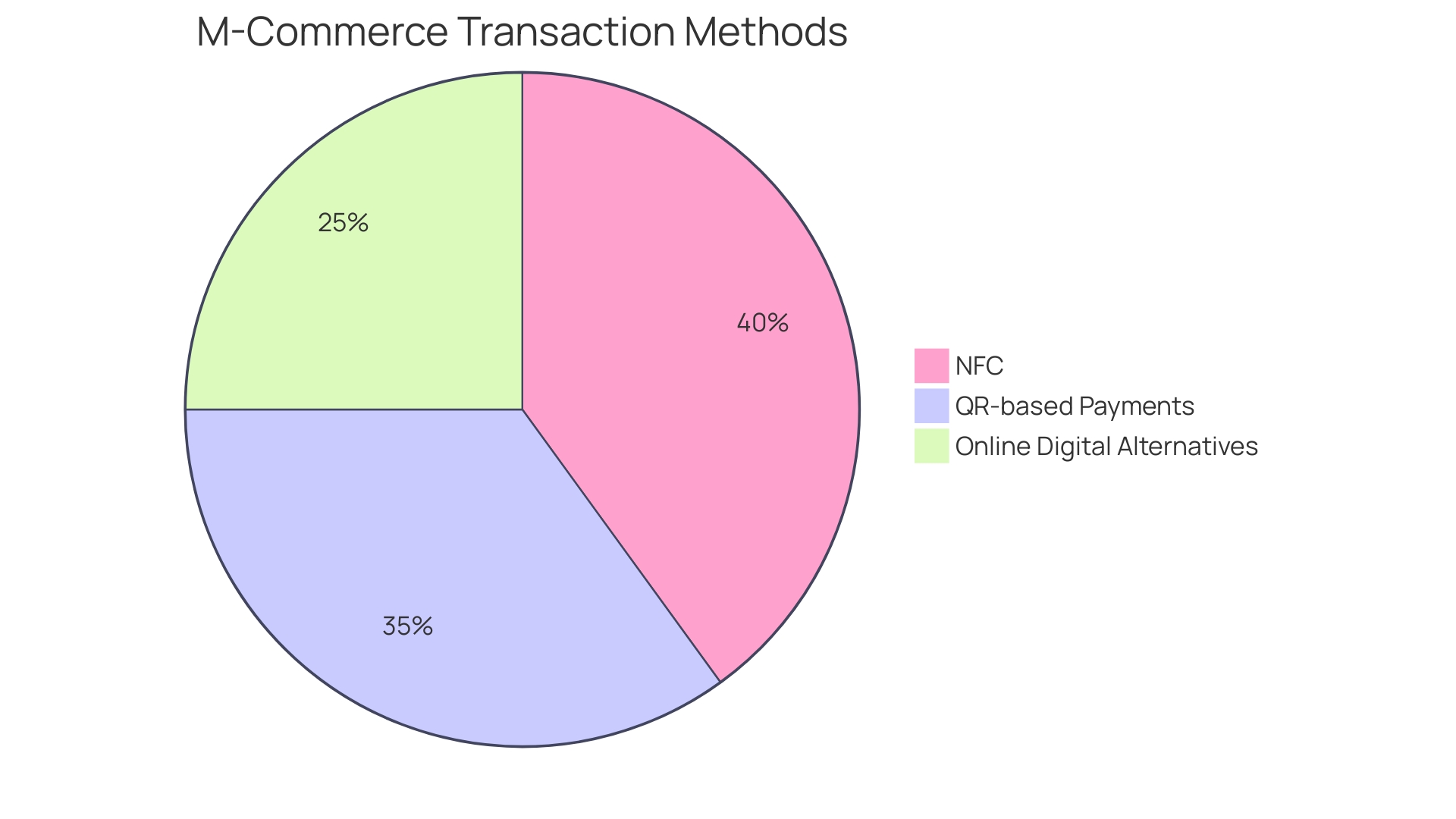
Types of Mobile Commerce
Mobile commerce (M-commerce) encompasses various types, each tailored to specific consumer needs and business models, making it essential for businesses to understand these categories to craft effective strategies.
-
Mobile Shopping Apps: These apps offer a seamless and personalized shopping journey. For instance, France TV's applications provide a personalized experience, allowing users to customize notifications to their interests. This level of customization can significantly enhance user engagement and drive sales.
-
Portable Transaction Platforms: Innovations such as the checkout-free store at Dublin Airport highlight the ease of portable transaction platforms. By allowing customers to scan their payment card and automatically charge them as they exit, businesses can streamline the buying process and improve customer satisfaction.
-
Cellular Advertising: With portable devices playing a crucial role in shaping customer behavior, cellular advertising has become increasingly important. Businesses must leverage mobile marketing strategies to reach their audience effectively, considering that many consumers now prefer to shop and interact with brands through their mobile devices.
-
Mobile Wallets: Mobile wallets such as Apple Pay and Google Wallet provide a secure and convenient method for customers to conduct transactions. These systems not only enhance the user experience but also encourage repeat purchases by simplifying the payment process.
-
Location-Based Services: Utilizing GPS technology, businesses can offer location-based services to provide relevant offers and information to customers based on their geographic location. This targeted approach can lead to higher engagement and conversion rates.
Grasping these kinds of commerce enables companies to customize their strategies to enhance engagement and sales, ensuring they remain competitive in the swiftly changing digital environment.
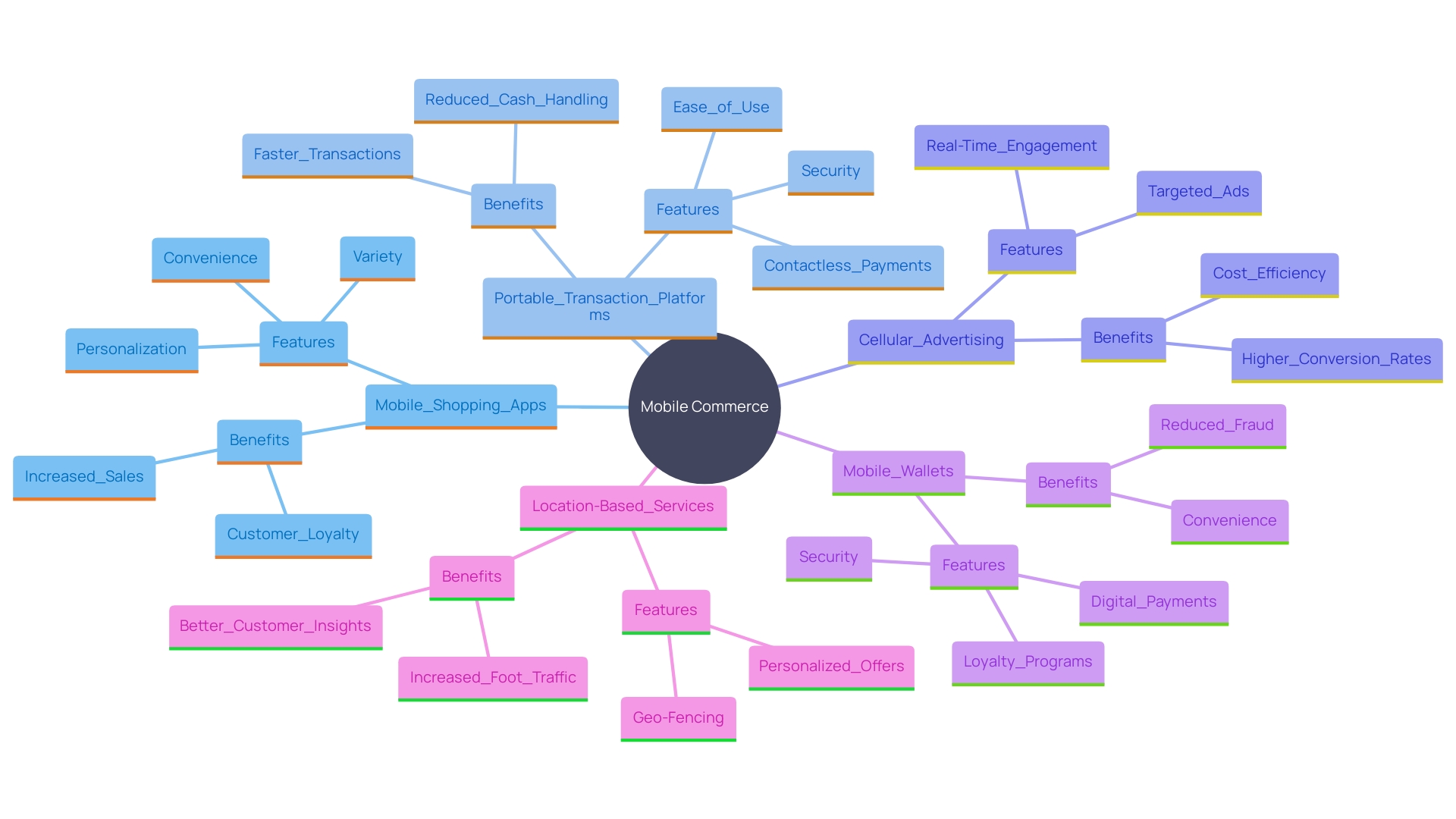
Mobile Shopping
Purchasing items and services through portable applications or optimized websites is known as remote buying. This approach enables consumers to explore products, compare prices, read reviews, and finalize transactions directly from their smartphones, significantly improving the purchasing experience with convenience and speed. Through user-centric applications, companies like Ripley, a leading retailer in Chile and Peru, have transformed their mobile commerce strategies to cater to the evolving demands of digital consumers.
Recent research by Retail Technology Review reveals that 72% of fashion and sportswear customers prefer a hybrid approach, enjoying both online and in-store experiences. The research emphasizes that more than half of consumers cherish the physical sensation of touching and feeling items, while a third value the opportunity to evaluate and contrast choices in-store. Additionally, 69% draw motivation from the in-store purchasing process, highlighting the essential function of online shopping in enhancing traditional retail.
The integration of cutting-edge technology, as seen in Dublin's new checkout-free store powered by Zippin technology, further illustrates the seamless blend of convenience and innovation in modern retail. By scanning a payment card to enter and using cameras and weight-sensored shelving to detect purchases, shoppers can enjoy a seamless process, epitomizing the future of commerce.
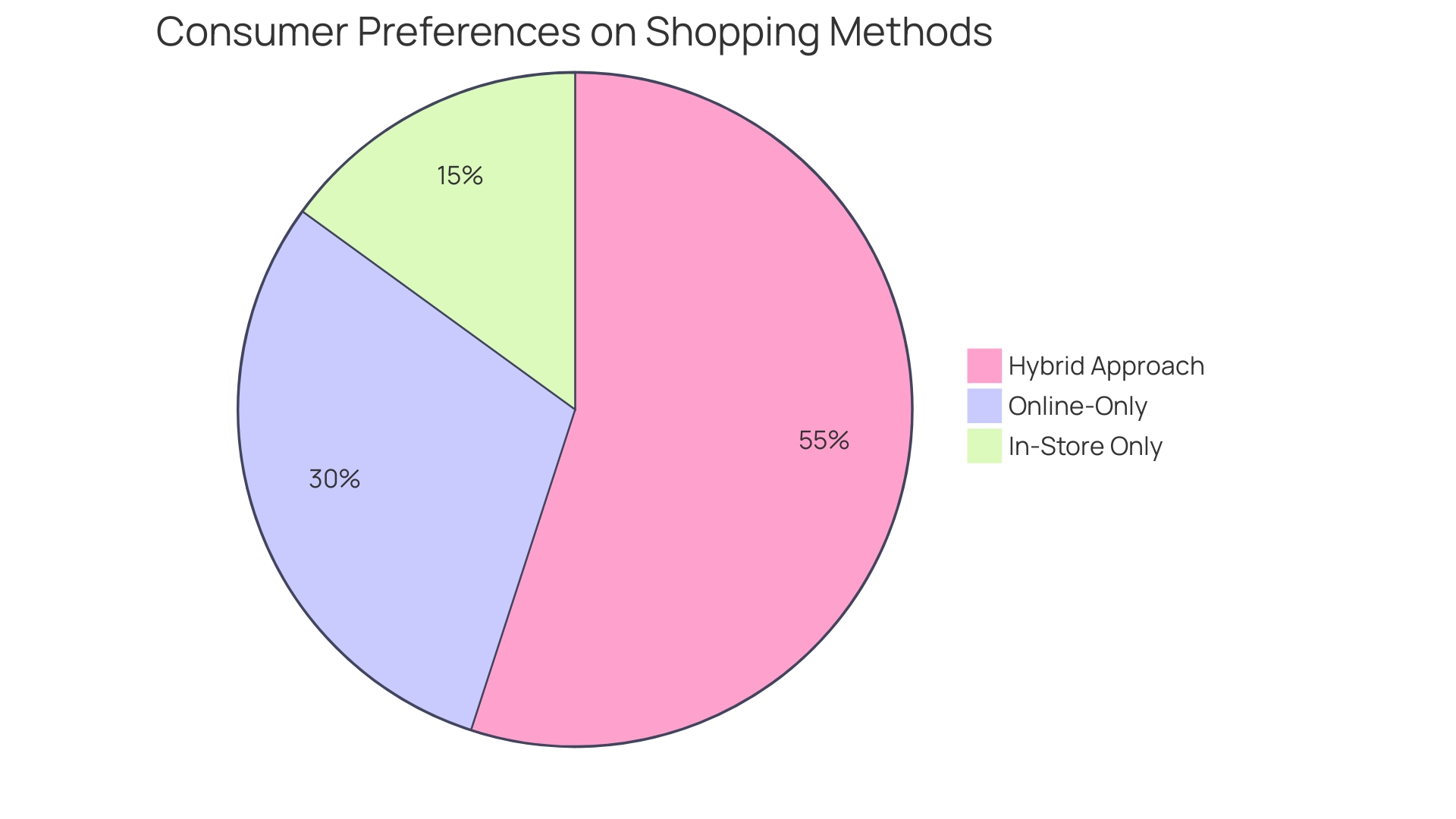
Mobile Banking
Banking through portable devices has transformed how we handle our finances, allowing users to carry out a broad array of monetary transactions using handheld gadgets. This includes checking account balances, transferring funds, and paying bills. Financial institutions have developed sophisticated apps that provide secure access to banking services, making it incredibly convenient for users to handle their finances on the go.
The transformation in the financial world, largely driven by the rise of financial technology (FinTech), has put traditional financial institutions under immense pressure to innovate and adapt. Digital banking, an essential element of this FinTech revolution, provides a streamlined and intuitive interface. For instance, YNAB (You Need A Budget) not only helps users budget but also provides a comprehensive suite of features and educational resources that support better financial management.
Artificial intelligence (AI) in banking leverages big data to analyze user behavior and provide personalized insights. These AI-driven insights can help users track their financial progress, manage expenditures, and even set and achieve personal financial goals. This technology integration ensures that users have a holistic view of their finances, enabling them to make informed decisions.
The shift towards digital banking is also reflected in user preferences. A significant number of customers now opt for online, digital, or telephone banking as their primary ways of managing finances. The current edition of the Digital Banking Maturity report highlights that banking leaders focus on creating outstanding value for customers by offering a full range of key banking operations and ensuring a seamless user experience. By the end of 2023, 5.6 billion individuals worldwide subscribed to a telecommunications service, with 4.7 billion also utilizing internet services, illustrating the widespread adoption and impact of connectivity in enhancing digital financial services.
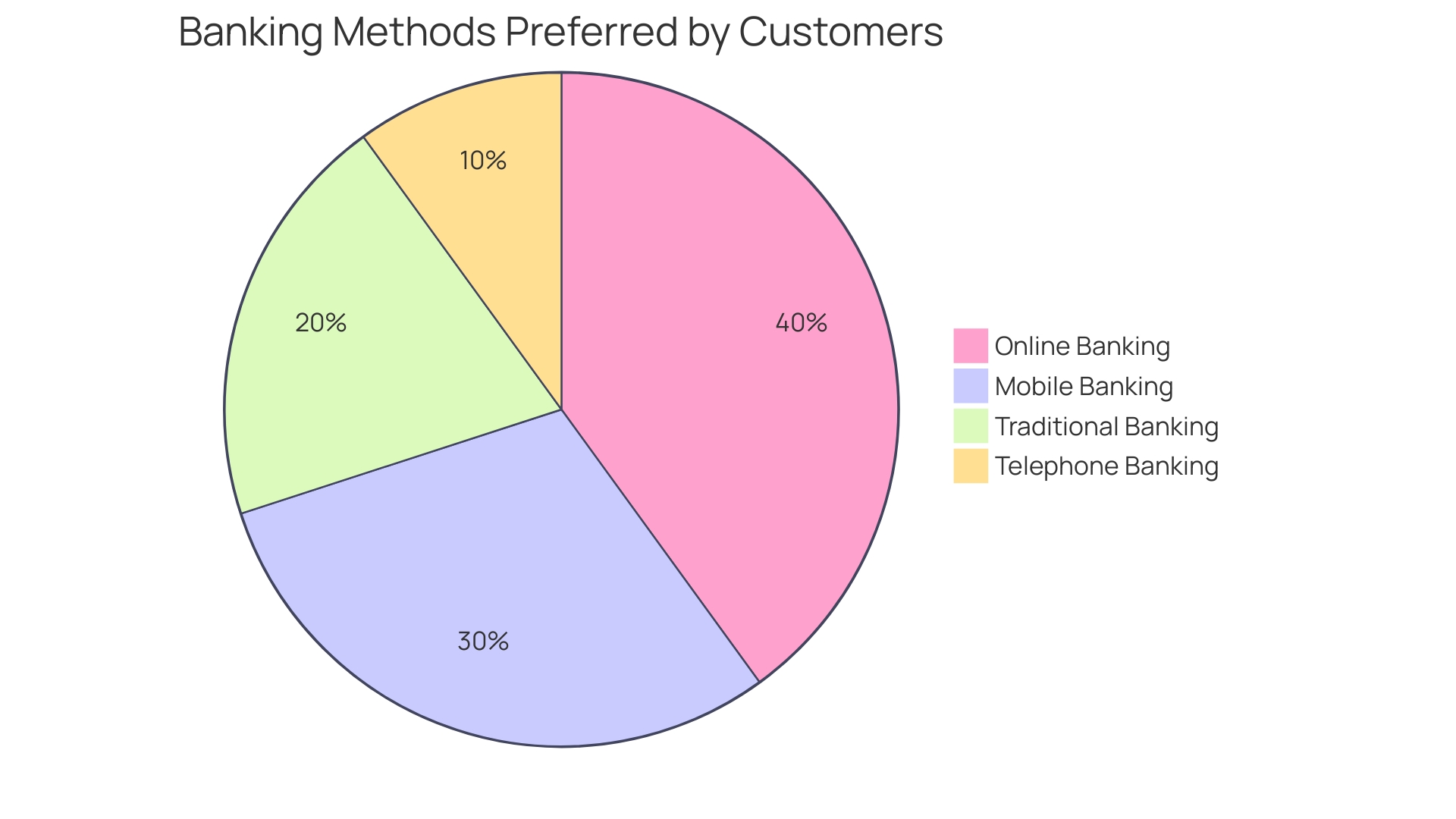
Mobile Payments
Mobile transactions revolutionize the way exchanges are conducted, leveraging technologies like NFC (Near Field Communication) and QR codes to facilitate seamless purchases through mobile devices. By linking directly to bank accounts or digital wallets, these financial methods eliminate the need for physical cash or cards, streamlining the checkout process.
The rise of digital wallets, projected to be used by over 5.2 billion people by 2026, exemplifies this shift. These wallets store encrypted transaction details, making exchanges not only faster but also more secure. For instance, the new Dublin Town To Go store at Dublin Airport, powered by Zippin technology, allows customers to scan their card to enter, automatically charging them for items as they leave. This checkout-free experience exemplifies the ease and effectiveness of digital transactions.
Traditional payment methods are rapidly being replaced by these innovative solutions, driven by the need for speed, security, and convenience. Furthermore, as companies strive to offer more sustainable alternatives, each transaction provides consumers the chance to make eco-friendly decisions, aiding in a more sustainable future.
Key Characteristics of Mobile Commerce
Mobile commerce (m-commerce) distinguishes itself from traditional e-commerce through several unique characteristics that enhance user engagement. Key among these is mobility, which allows consumers to shop from anywhere, at any time, providing unparalleled convenience. This real-time access ensures that users can make purchases and interact with brands instantly, fulfilling the modern demand for immediacy. Furthermore, m-commerce leverages location-based services to offer personalized experiences, tailoring product recommendations and promotions to the user's specific location.
The increase of portable invoicing and contactless transactions has also contributed greatly to m-commerce's expansion. 'The mobile transaction sector is expanding rapidly, driven by technologies like sound wave-based methods and the increasing penetration of smartphones, especially in emerging markets.'. This shift not only makes transactions more convenient but also integrates seamlessly with the growing demand for digital and contactless payment methods, a trend accelerated by the COVID-19 pandemic.
Additionally, the integration of physical and digital purchasing experiences—referred to as 'phygital'—has become crucial. Shoppers anticipate verifying product availability on their handheld devices and finalizing transactions either online or in physical locations, indicating a combined shopping approach. As Keith Kirkpatrick of The Futurum Group notes, this integration puts the customer first, ensuring efficiency and convenience. The ongoing progress in AI and data connectivity is anticipated to further improve these abilities, making commerce an increasingly essential component of the retail environment.
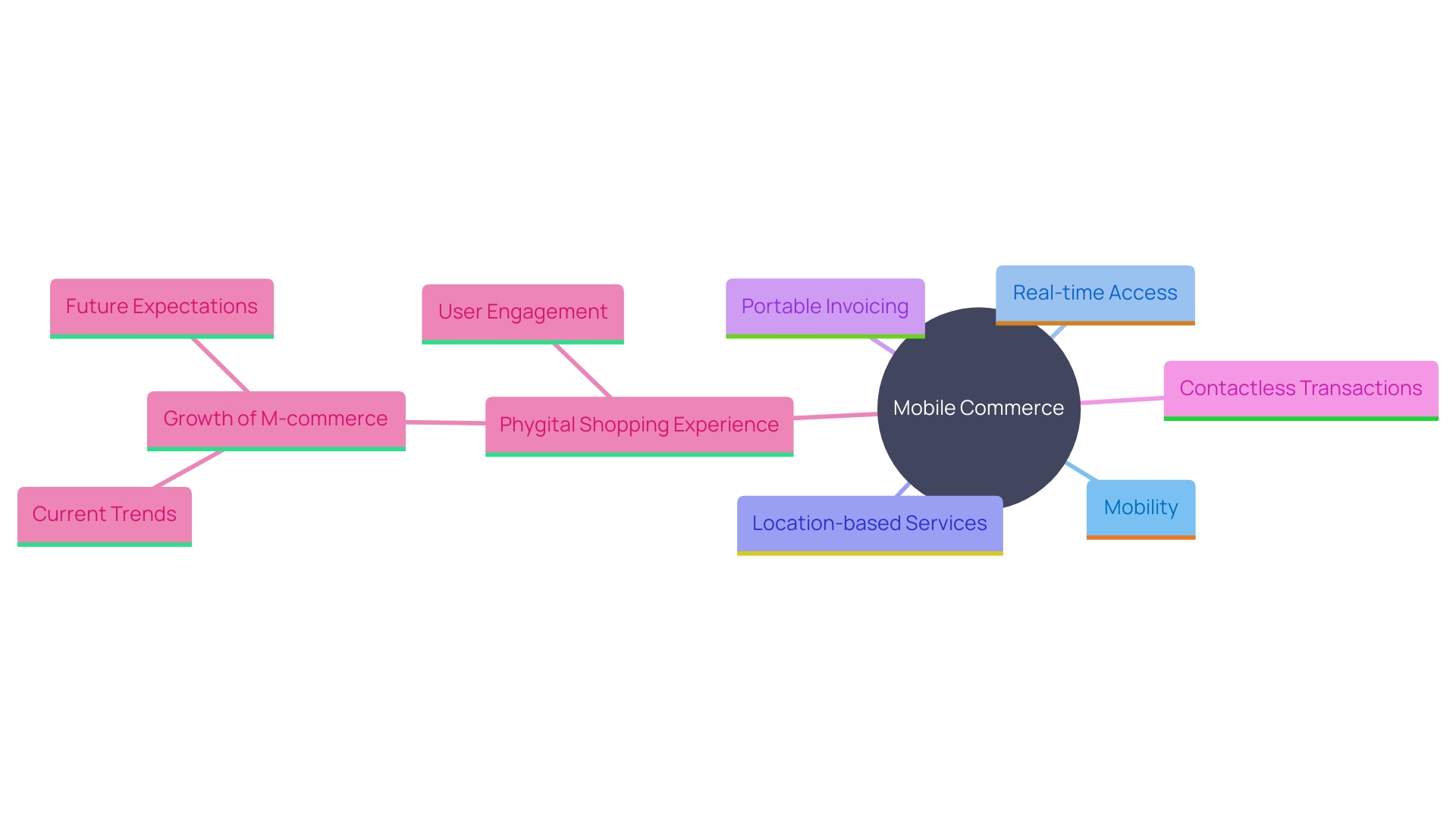
Benefits of Mobile Commerce
Mobile Commerce (M-Commerce) offers a multitude of benefits, significantly enhancing both consumer and business experiences. As portable gadgets become essential to daily living, companies can utilize enhanced accessibility and a wider reach. For example, Bemol, a prominent retail chain in Brazil, successfully utilized technology to provide reliable connectivity in remote Amazonian regions, thereby enhancing customer engagement through personalized marketing and free public Wi-Fi.
Furthermore, the incorporation of portable transactions has streamlined exchanges, boosting sales with ease. Mobile billing, which is rapidly gaining popularity, allows customers to shop and pay without cash or cards. This trend is supported by the rising adoption of sound wave-based transactions, smartphone proliferation, and the increasing use of portable financial solutions in emerging economies. 'According to recent statistics, the remote transaction segment held a market share of around 60% in 2022, highlighting the shift towards seamless digital exchanges.'.
Moreover, the COVID-19 outbreak has increased the need for contactless transactions, further driving the market for portable financial solutions. This change is illustrated by advancements such as the checkout-free store at Dublin Airport, where shoppers can purchase items without queuing, thanks to sophisticated portable transaction technologies. As Dr. Story Edison, an expert in consumer behavior, states, “A seamless payment experience is crucial in maintaining customer loyalty and driving continuous sales.”
In essence, the rise of M-Commerce is transforming the retail landscape by providing enhanced accessibility, personalized customer engagement, and simplified, secure transactions, ensuring businesses remain competitive in a rapidly evolving market.
M-commerce vs. E-commerce
Though both M-commerce and e-commerce enable online transactions, the main distinction is in the platforms employed. E-commerce generally entails purchasing and selling using desktops or laptops, while M-commerce emphasizes transactions carried out through portable devices such as smartphones and tablets. This evolution towards portable platforms mirrors a significant shift in consumer behavior and preferences. In 2024, over 2.71 billion people are expected to shop online, highlighting how technology reshapes shopping habits. Data from a Bank of America survey indicates that 42% of U.S. respondents plan to increase their online spending, driven largely by convenience. The retail sector, particularly during busy periods such as Black Friday, experiences significant growth in online transactions, highlighting the increasing influence of commerce conducted via smartphones in our daily lives.
Future of Mobile Commerce
The future of Mobile Commerce is set to experience transformative growth, propelled by cutting-edge technologies like 5G, augmented reality, and artificial intelligence. 'With cellular connectivity impacting 5.6 billion individuals worldwide by the end of 2023, the role of commerce via devices in the global economy is undeniable.'. In 2023, wireless technologies and services accounted for 5.4% of the global GDP, totaling $5.7 trillion in economic value.
5G technology is poised to revolutionize the mobile commerce landscape by enabling faster data speeds, reduced latency, and more reliable connections. This will not only improve user interactions but also simplify transactions, making them more efficient and secure. Augmented reality (AR) will enable businesses to create engaging interactions, where customers can try out products virtually before making a purchase, thereby reducing return rates and enhancing customer satisfaction.
Artificial intelligence (AI) will play a crucial role in customizing the purchasing journey. AI-driven algorithms can analyze customer behavior and preferences to provide tailored recommendations, enhancing the overall user interaction. Moreover, AI can assist in inventory management and fraud detection, ensuring a seamless and secure purchasing journey.
The integration of these technologies will create new opportunities for businesses to engage with customers in innovative ways. For instance, the rise of 'phygital' stores, which merge physical and digital retail strategies, will offer a cohesive customer journey. Customers will gain from a seamless purchasing experience, whether they are browsing online or visiting a physical store equipped with AR and AI tools.
Furthermore, the increasing focus on sustainable consumption will affect commerce on portable devices. Companies will offer customers practical details regarding the environmental effects of their purchases, allowing for more mindful and sustainable selection choices. This shift towards sustainable commerce is expected to become more prominent, with each transaction offering an opportunity for consumers to contribute positively to the planet.
In essence, the future of portable commerce is not just about technological advancements but also about creating a more engaging, personalized, and sustainable purchasing experience. By leveraging the latest technologies, businesses can stay ahead of the curve and meet the evolving demands of today's tech-savvy consumers.
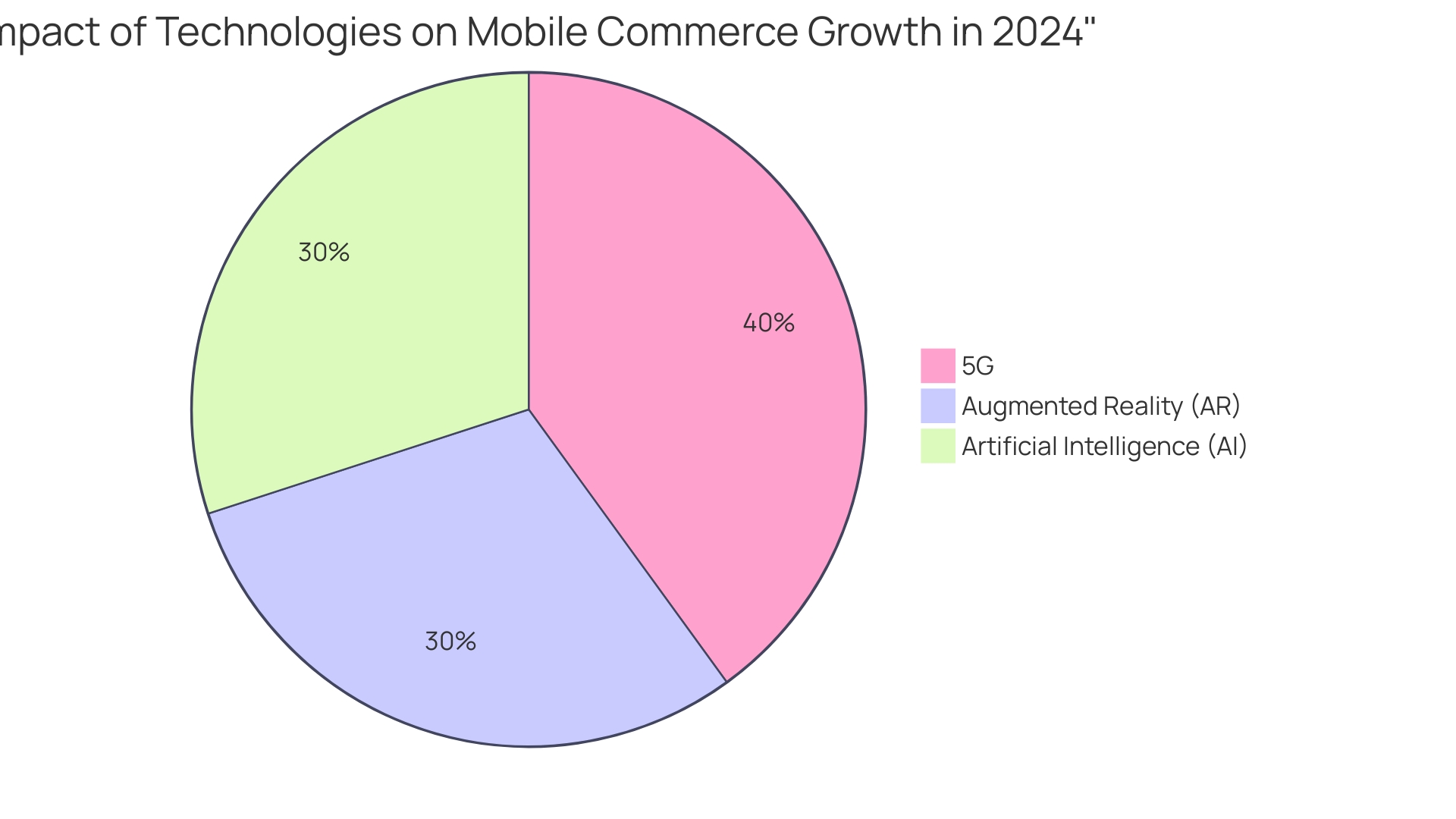
Trends in Mobile Commerce
Current trends in Mobile Commerce include the rise of social commerce, the increased use of mobile wallets, and the growing significance of app-based purchasing. Social commerce is becoming a significant player, with studies showing that 32% of consumers appreciate the ease and familiarity of buying on social media platforms, while 28% value the swift purchase process. Moreover, a recent research study emphasizes that 72% of fashion and sportswear consumers favor shopping both online and in-store, aiming for a uniform interaction across channels. The tactile experience of physical stores, combined with the ease of shopping via smartphone, is driving this trend. Additionally, digital wallets are gaining popularity, further boosted by the need for contactless transactions during the COVID-19 pandemic. Financial innovations such as sound wave-based transactions and the increased adoption of smartphones, particularly in developing economies, are key drivers. The mobile payments industry, with major players like Google, PayPal, and Visa, is poised for significant growth despite challenges like security issues. Lastly, the importance of app-based shopping cannot be overstated, with the holiday shopping season exemplifying this shift. In 2022, online sales in the U.S. surged to $303.1 billion in the fourth quarter, a 23.4% increase over the quarterly average for the first nine months of the year. Understanding these trends allows businesses to adapt and optimize their strategies, ensuring they remain competitive in the evolving digital landscape.
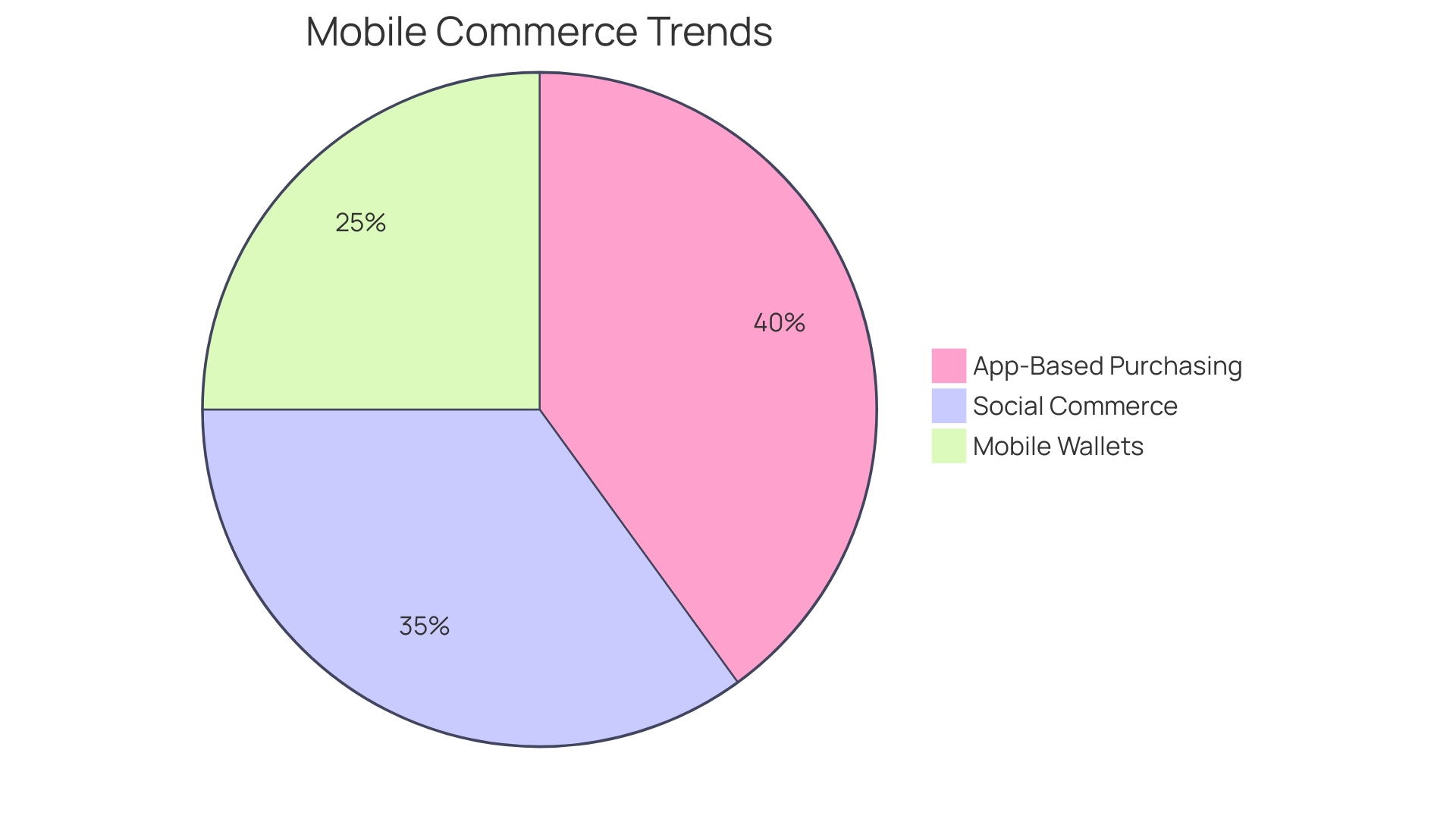
Conclusion
Mobile Commerce (M-Commerce) represents a transformative shift in how transactions are conducted, driven by the increasing prevalence of mobile technology. It encompasses various forms of digital transactions via mobile devices, offering unparalleled convenience and accessibility for both consumers and businesses. The rise of mobile payments, shopping apps, and banking solutions illustrates the significant impact M-Commerce has across sectors, reshaping consumer behavior and expectations.
Understanding the diverse types of M-Commerce—ranging from mobile shopping and payment systems to location-based services—empowers businesses to craft targeted strategies that enhance user engagement and streamline operations. The integration of advanced technologies such as AI and 5G will continue to revolutionize the landscape, providing users with personalized experiences and real-time accessibility.
As M-Commerce continues to evolve, its benefits are clear: increased reach, simplified transactions, and enhanced customer loyalty. The ongoing shift towards mobile solutions is not merely a trend but a fundamental change in the retail and financial landscapes. Businesses that adapt to these changes and embrace emerging technologies will not only stay competitive but also thrive in the dynamic digital marketplace.
Ultimately, the future of M-Commerce promises to deliver a more engaging, efficient, and sustainable shopping experience for consumers worldwide.





